#Lenggalgak
Explore tagged Tumblr posts
Text
Bestiaryposting Results: Miscellaneous "Worms"
Here is what I intended to be our final Bestiarypost: all the animals from the "worms" section of the Aberdeen Bestiary.
I checked, there's not a big missing portion this time. "Worms" only get two pages.
I put quotation marks around "Worms" here because what medieval writers would call "worms" and what we would call "worms" are not the same. The medieval sense is somewhat preserved in the modern word "vermin", but in other ways it's closer to "bugs". Really, it's broader than either of those terms are for us, because it more or less means "any animals that are very very small."
Anyway, if you don't know what I'm talking about, answers can be found at https://maniculum.tumblr.com/bestiaryposting.
If you want to see the entry people are working from, it's here:
And if you want to see the entry for the next (and, unless something goes awry, final) week of Bestiaryposting, it's here:
Now, art below the cut:
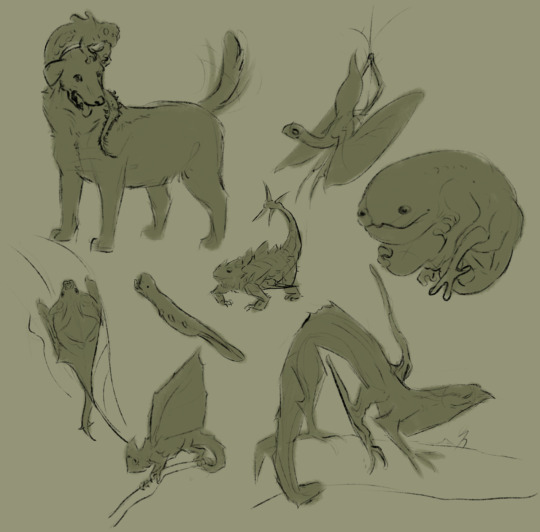
@silverhart-makes-art (link to post here) decided to make these into wyrms, with a "y", and I think they came out well. The Lenggalgak and Shmigwanog are probably the coolest-looking, but I also like the Phlerotger. Silverhart calls it a "horrible little creature" but I think it's charming how... shameless it looks about that. More details on all of these in the linked post.
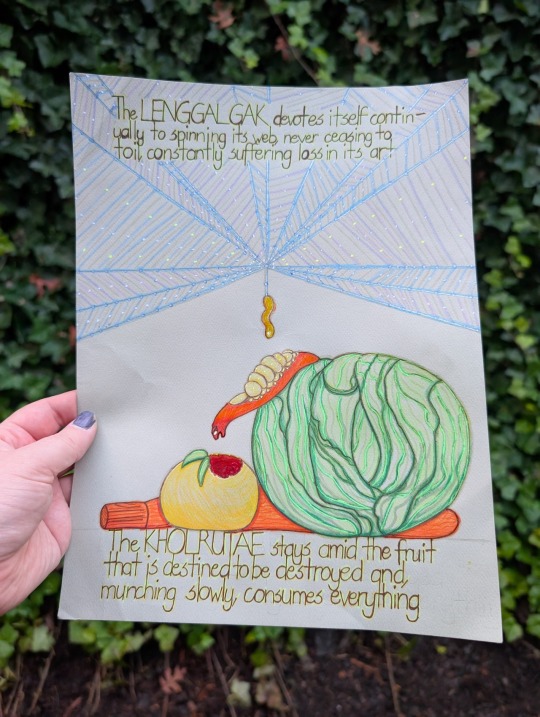
@wendievergreen (link to post here) has drawn two of them in this very nicely stylized artwork here. I like the detail added by including the Lenggalgak's web and some plants for the Kholruntae to eat. I really like the inclusion of evocative bits from the entry as captions. (Also, thank you for including alt text.)
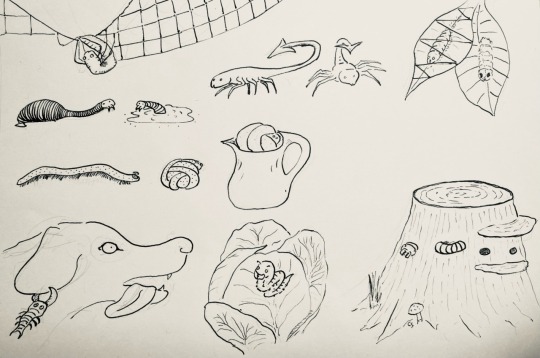
@cheapsweets (link to post here) has done the whole set here. I like the depiction of the Khrezaroth swelling in a pitcher, and the kind of charmingly goofy Phlerotger. Also they pretty clearly have the Logkashgae's number -- which is to be expected, given where this whole project started.
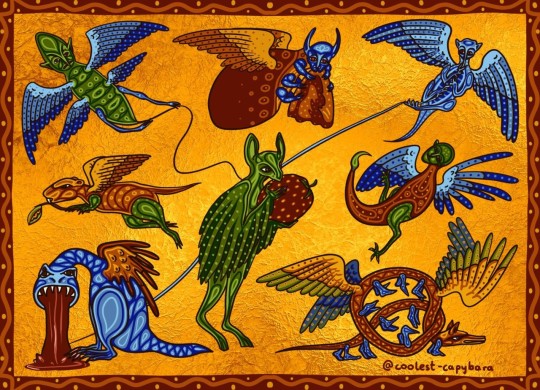
@coolest-capybara decided to go with the theme of "what medieval illustrators might draw when they have no idea what the animal is and decide to get weird with it." I absolutely love all of these, but I think the Khrezaroth is running away with this one. All of them really would fit into the margins of a suitably fancy medieval manuscript. (And I think they might also have clocked the Logkashgae, judging by the face.)
Now, the Aberdeen Bestiary. None of these get illustrations -- they're just brief little blurbs crammed into two pages, so there didn't seem to be any motivation to add pictures.
The section does, however, start with this rather nice inhabited initial:
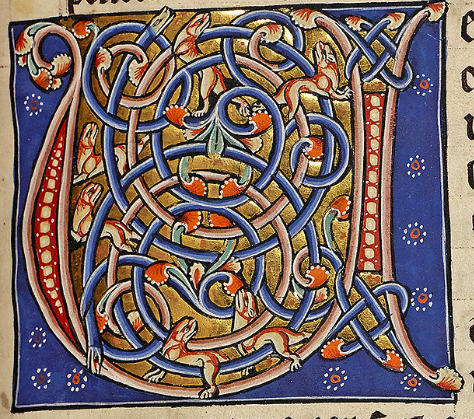
(This is of course the first letter of "Uermis".)
The entry starts with this helpful introduction:
Here begins the account of worms The worm is a creature which generally springs from flesh, or wood or some other earthly material, but not as the result of intercourse, although occasionally they are hatched from eggs, like the scorpion. There are worms that live in earth or in water, in air, in flesh, in leaves or in wood, or in clothes.
Again they are trying to define "worm", but the fact of the matter is that it's mostly vibes-based. The author suggests that worms are anything formed through spontaneous generation, but then notes that some of them, like scorpions, lay eggs. And, of course, in the Miscellaneous Mammals entry, we learned that mice form through spontaneous generation, but they're not listed with the worms.
Anyway, here are their identities:
Lenggalgak
This is of course the spider, which is apparently called aranea on account of it living on air. Maybe the author didn't know what the web was actually for, and figured its tendency to catch insects was an accident.
Khrezaroth
The worm with many feet that rolls in a ball is the millipede. I haven't seen any swell in pitchers, but I'm sure they could if they wanted.
Phlerotger
The bloodsucker is the leech, naturally. "So called" because the Latin term given by the author is sanguissuga.
Logkashgae
In a bit of a full-circle moment, this is the scorpion. I've written a lot about these already, so we'll just move on.
Burlebroth
The worm that makes silk is the silkworm, surprising nobody, I'm sure. I can't explain the name thing this time, because the Latin name given is bombocis.
Kholruntae
Interestingly, this is the caterpillar. Odd that it is specified not to fly, when in fact it's one of the only ones on this list that does. Just... not until after it metamorphoses.
Shmigwanog
The wood worm is the termite, which makes sense.
Feabladtae
Finally, the worm that sticks to dogs' ears is the tick.
Misc.
There are also several that I intentionally left out this time, because there was even less of them to make into these little entries. Here's the rest for your perusal, however:
The worm found in clothes is called tinea because it gnaws at fabrics, and burrows into them until they are eaten away. For this reason, it is called pertinacious, pertinax, because it works away all the time at the same thing. Worms of the body are the emigramus, the stomach-worm, the ascaride, the coste, the louse, the flea, the lendex, the tarmus, the tick, the usia, the bug. The emigramus is a worm of the head. The stomach-worm, lumbricus, creeps into or lives in the loins, lumbus. Lice, pediculi, are worms of the body which get their name from their feet, pedes; people on whose bodies lice swarm are called lousy, pediculosi. Fleas, pulices, however, are so called because they live mainly on dust, pulvis. The tarmus is a worm found in pork fat... The usia is a worm found in pigs, so called because it burns, urere. For when it bites, the place burns so much that blisters form. The bug, cimex, gets its name from its resemblance to a plant which has the same stench; properly speaking, this worm originates in putrid meat.
There is also this helpful little conclusion:
To repeat, you find the moth in clothes, the caterpillar in vegetables, the termite in wood and the tarmus in pork fat. The worm does not crawl like a snake with visible steps or by the pressure of its scales, because it lacks the firm spine which you find in snakes; but, moving in a straight line, by expanding the contracted parts and contracting the expanded parts of its little body, it unfolds in motion and, impelled in this way, creeps forwards.
So there you have it. Worms.
#maniculum bestiaryposting#maniculum miscellaneousworms#Lenggalgak#Khrezaroth#Phlerotger#Logkashgae#Burlebroth#Kholruntae#Shmigwanog#Feabladtae
21 notes
·
View notes
Text

Maniculum Bestiaryposting Challenge: Miscellaneous Worms
These were super fun to do! The way this section was arranged, with the "worms" being listed according to their "element" and special abilities, made me think of a magical girl group.
So, instead of getting too much into which specific animal might be described (some of which I was pretty certain about), I went with the same basic body plan bestiary illustrators sometimes to default to when they don't know what something looks like: Some legs, wings, maybe a tail and a vaguely dog-like head. Then I added some vaguely related attributes and colors. Descriptions are below the cut:
Clockwise, from the top right:
The Lenggalgak is a worm of the air, and gets its name from the fact that it lives on air; it draws out long threads from its small body, and devotes itself continually to spinning its web, never ceasing to toil, constantly suffering loss in its art.
The Logkashgae is a land worm, to be classed rather with worms than snakes; it is armed with a sting, and from that it gets its Greek name, because it sticks its tail into its victim and spreads the poison through the bow-shaped wound. It is a characteristic of the Logkashgae, that it will not sting the palm of the hand.
The land-based Khrezaroth is so called from its large number of feet; rolled up in a ball, it swells in pitchers.
The Kholruntae is a leaf worm, often found enveloped in a cabbage or a vine; it gets its name from [redacted]. It folds itself up and does not fly about like the locust, which hurries from place to place, in all directions, leaving things half-eaten, but stays amid the fruit that is destined to be destroyed and, munching slowly, consumes everything.
The Phlerotger [very fitting name! Love it], a water worm, is so called because it sucks blood, and takes by surprise anyone who is drinking water. When it slides down the throat or adheres to any other part of the body, it drains the blood and when it can hold no more, it vomits what it has already swallowed in order to start sucking fresh blood again.
The Greeks call the wood worm [redacted] because they eat by gnawing their way into wood. We call them Shmigwanog, for in Latin that is the name given to wood worms, which are hatched from trees felled at the wrong season.
The Burlebroth is a leaf worm; from the threads it weaves, we make silk. It gets its name because it empties itself when it makes thread and only air is left inside its body.
The Feabladtae is a worm associated with dogs, so called because it sticks to their ears.
#maniculum bestiaryposting#digital art#my art#medieval aesthetic#maniculum miscellaneousworms#Lenggalgak#Khrezaroth#Phlerotger#Logkashgae#Burlebroth#Kholruntae#Shmigwanog#Feabladtae
7 notes
·
View notes
Text
A Muddle of Miscellaneous "Worms"

My entry in this week’s (final!) Maniculum bestiaryposting challenge from @maniculum
Pencil sketch, then lines in TWSBI Eco fountain pen, extra fine nib, using Monteverde Raven Noir ink.
Descriptions below the cut (hopefully it’s obvious which is which);
In general, I went with the understanding that ‘worm’ in a medieval context is a bit of a catch-all clade for creepy crawlies (including terrestrial arthropods, molluscs, various actual worms, and pretty much anything small that isn’t a beast, bird, serpent or fish…). As such we have a variety of generic creatures which take inspiration from various invertebrates without being too accurate!
Lenggalgak
The Lenggalgak is a worm of the air, and gets its name from the fact that it lives on air; it draws out long threads from its small body, and devotes itself continually to spinning its web, never ceasing to toil, constantly suffering loss in its art.
Khrezaroth
The land-based Khrezaroth is so called from its large number of feet; rolled up in a ball, it swells in pitchers.
Phlerotger
The Phlerotger, a water worm, is so called because it sucks blood, and takes by surprise anyone who is drinking water. When it slides down the throat or adheres to any other part of the body, it drains the blood and when it can hold no more, it vomits what it has already swallowed in order to start sucking fresh blood again.
Logkashgae
The Logkashgae is a land worm, to be classed rather with worms than snakes; it is armed with a sting, and from that it gets its Greek name, because it sticks its tail into its victim and spreads the poison through the bow-shaped wound. It is a characteristic of the Logkashgae, that it will not sting the palm of the hand.
Burlebroth
The Burlebroth is a leaf worm; from the threads it weaves, we make silk. It gets its name because it empties itself when it makes thread and only air is left inside its body.
Kholruntae
The Kholruntae is a leaf worm, often found enveloped in a cabbage or a vine; it gets its name from [redacted]. It folds itself up and does not fly about like the locust, which hurries from place to place, in all directions, leaving things half-eaten, but stays amid the fruit that is destined to be destroyed and, munching slowly, consumes everything.
Shmigwanog
The Greeks call the wood worm [redacted] because they eat by gnawing their way into wood. We call them Shmigwanog, for in Latin that is the name given to wood worms, which are hatched from trees felled at the wrong season.
Feabladtae
The Feabladtae is a worm associated with dogs, so called because it sticks to their ears.
#my art#maniculum bestiaryposting#bestiaryposting#maniculum miscellaneousworms#art challenge#bugs#Lenggalgak#Khrezaroth#Phlerotger#Logkashgae#Burlebroth#Kholruntae#Shmigwanog#Feabladtae
6 notes
·
View notes
Text
Miscellaneous 'Worms' (Lenggalgak, Kholruntae)

Oh worm?🪱
I picked these wee beasties based on the entries. So evocative!
I decided to really lean into the worm of it all to try and reduce the resemblance to the Real Small Friends.
The Lenggalgak is inspired by some itty bitty little yellow caterpillars my family was absolutely beset by last time we went to Mt Hood😅 couldn't turn your head without a little guy swinging into your face!
The Kholruntae is one part slug, one part pillbug (/potato bug/rolly-polly/et c), all vibes. The fruit is also just vibes, unless it turns out there actually is an orange zucchini or yellow tomato with red guts out there somewhere🤔
Between this and my miscellaneous lizards, I've learned I really like how bright colors pop on earth-toned paper!
5 notes
·
View notes
Text
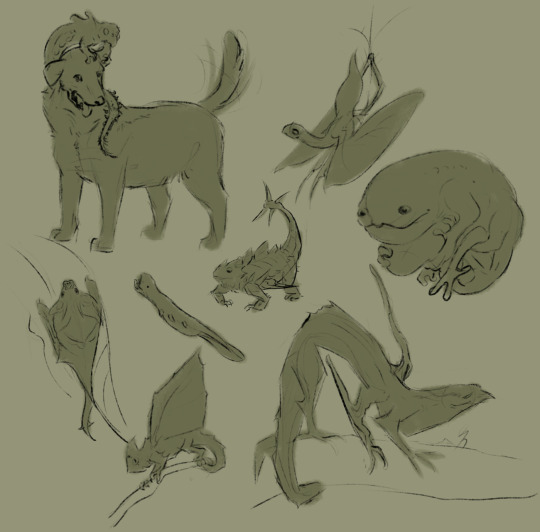
This week's Bestiary Posting is a collection of worms! I opted to interpret 'worms' as wyrms (aka weird little dragons with six limbs), because drawing a bunch of legless, eyeless, boneless cylinders did not appeal to me. Sorry worms, I love ya, but there's not a lot I can do with a worm in a quick sketch like this. So we're going with dragons, some of which are at least a little wormy.
Labeled version and more detailed explanations below.
Lenggalgak - a "worm of the air" needed wings to fly through it. It also has four thin appendages for spinning it's web. Seems odd that an animal that makes a web, and thus stays in one place would need to fly, but maybe they use their wings like spiderlings use silk parachutes to float to new homes, and the sedentary adults just use their wings for display.
Khrezaroth - this was meant to be a frog/salamander type thing, and ended up looking nothing like those animals. Still, I like his silly face, and even curled up he has way too many legs (but it's still six - we've got a very specific body plan here).
Phlerotger - Mix between a leech, a tadpole and a cookie cutter shark. It's lost it's limbs and just has little spurs like you see in some snakes. One of the few actually worm-shaped worms here, since it apparently needs to slide down the throat. Absolutely horrible little creature.
Logkashgae - was thinking what could possibly make a bow shaped wound, and decided a thagomizer might do the trick. So horned lizard-stegosaur with a scorpion stance. It's middle limbs have evolved into spikes.
Burlebroth - the description said it was a leaf worm, therefor it must look like a leaf. A leaf-tailed gecko meets a katydid with a bit of chameleon for color.
Kholruntae - since it's said to curl up in leaves my mind went to the Honduran white bats who are very tiny and roost in leaves. Worth looking up some pictures if you want a smile - they're adorable. Basically drew that, but with scales that make it look like a leaf and a long tail.
Shmigwanog - it's a "wood worm", a little stick dragon with the head of a potoo. It's folded wings look like little branches, to help it camouflage even more amid the branches.
Feabladtae - okay, this one is inspired by something I heard from a vet many years ago, about how you can tear a Labrador's ear off and they'd still be wagging their tail. Said in reference to my own Labrador who was quite happily wagging her tail while being treated for an insect bite/sting that had her face swelling to three times it's size. She always loved the vet, no matter how painful the pokes and prods. So in honor of her can't-get-me-down attitude, I've drawn a lab lending their ear to their good Feabladtae friend. As a parasite it doesn't really need it's limbs, so it only has two stubby front limbs, and instead uses it's tail which is covered in little prickles to hold onto it's host's fur.
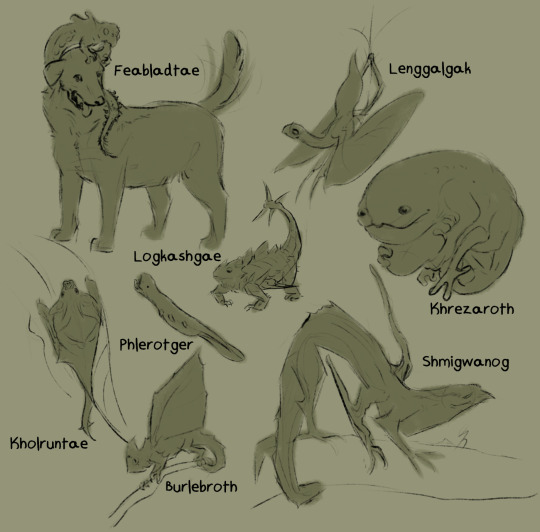
13 notes
·
View notes
Text
Bestiaryposting -- Miscellaneous "Worms"
As a reminder, all previous entries in this series can be found at https://maniculum.tumblr.com/bestiaryposting .
Another reminder: as mentioned in the initial post, the last six weeks of this project are group posts. Each is a collection of various critters that had particularly short entries, and I figured the best approach was to group them together so people could make art of some / any / all / none of them as they pleased, without feeling obligated to drag inspiration out of like one sentence. (Also doing this allowed me to fit the project into one year -- some of the longer entries in these are the result of me cutting the project down.)
Lenggalgak
The Lenggalgak is a worm of the air, and gets its name from the fact that it lives on air; it draws out long threads from its small body, and devotes itself continually to spinning its web, never ceasing to toil, constantly suffering loss in its art.
Khrezaroth
The land-based Khrezaroth is so called from its large number of feet; rolled up in a ball, it swells in pitchers.
Phlerotger
The Phlerotger, a water worm, is so called because it sucks blood, and takes by surprise anyone who is drinking water. When it slides down the throat or adheres to any other part of the body, it drains the blood and when it can hold no more, it vomits what it has already swallowed in order to start sucking fresh blood again.
Logkashgae
The Logkashgae is a land worm, to be classed rather with worms than snakes; it is armed with a sting, and from that it gets its Greek name, because it sticks its tail into its victim and spreads the poison through the bow-shaped wound. It is a characteristic of the Logkashgae, that it will not sting the palm of the hand.
Burlebroth
The Burlebroth is a leaf worm; from the threads it weaves, we make silk. It gets its name because it empties itself when it makes thread and only air is left inside its body.
Kholruntae
The Kholruntae is a leaf worm, often found enveloped in a cabbage or a vine; it gets its name from [redacted]. It folds itself up and does not fly about like the locust, which hurries from place to place, in all directions, leaving things half-eaten, but stays amid the fruit that is destined to be destroyed and, munching slowly, consumes everything.
Shmigwanog
The Greeks call the wood worm [redacted] because they eat by gnawing their way into wood. We call them Shmigwanog, for in Latin that is the name given to wood worms, which are hatched from trees felled at the wrong season.
Feabladtae
The Feabladtae is a worm associated with dogs, so called because it sticks to their ears.
Remember to tag posts with either the names of the critters you picked from the group and/or simply "maniculum miscellaneousworms" so folks can find them.
#maniculum bestiaryposting#maniculum miscellaneousworms#Lenggalgak#Khrezaroth#Phlerotger#Logkashgae#Burlebroth#Kholruntae#Shmigwanog#Feabladtae
19 notes
·
View notes